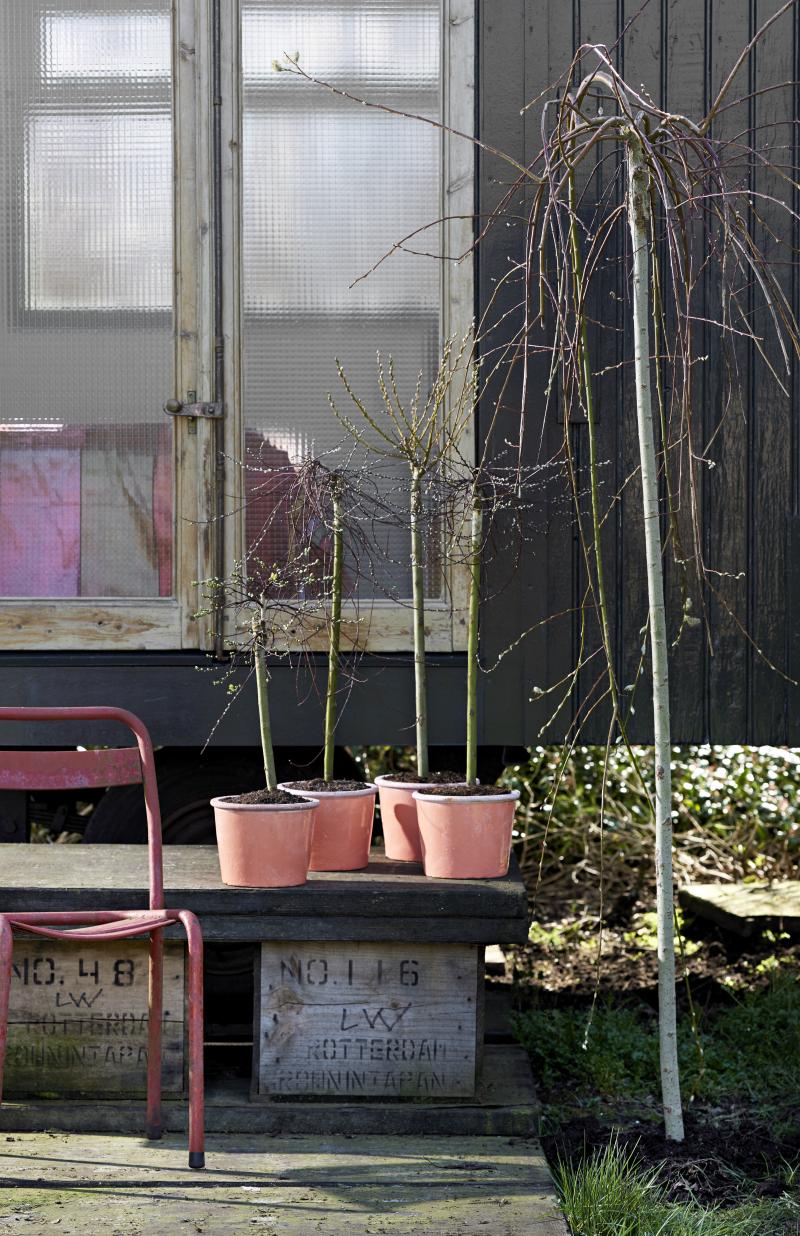February Garden Plant of the Month: Salix
Smaller Salix (Willow) is a welcome addition to any garden or patio. The branches can reach upwards, but can also hang down low. First soft, silver-white catkins emerge (which is the Salix’s version for flowering), later the green leaves appear, and in winter the stems are an attractive ochre colour.
The garden Salix is the mini version of the large pollard and weeping willows that grace parks, riverbanks and roads. These willow bushes are usually grafted onto a tall trunk, so that they offer the opportunity to create attractive combinations with colourful underplanting. Hence Salix combined with Primula, violas or narcissi for example can quickly become a cheerful Spring feature in the garden or patio.

Range
The best-known in the range of mini-willows is the Salix caprea ‘Kilmarnock’, the small weeping willow. This is supplied with tall trunks which range from a few dozen centimetres to a few metres, of which the twigs with catkins hang down. Other ‘standard willows’, which are offered as dwarf varieties are arbuscula, helvetica and subopposita and cultivars such as ‘Yalta’, ‘Iona’, ‘Voorthuizen’ (Creeping Willow). The appeal lies in the twigs with catkins - the leaves only developed later. Species that are sold particularly for their leaf colour are the Japanese or variegated willows, Salix 'Flamingo' and S. 'Nakuro Hishiki’, which both feature small pink leaves.
Salix trivia
• Willow catkins are an important source of pollen for insects, and attract useful honey bees and bumble bees.
• Salix appears in both Celtic and Germanic sagas. The flexible wood is often seen as a metaphor for resilience in the face of adversity.
• Because Salix grows so quickly, the tree is the symbol of fertility.
• The light wood of the Salix is the ideal wood for clogs.
• The twisted willow Salix babylonica 'Tortuosa' is popular as an Easter tree.
Origin
Salix is a classic from the Low Countries that spread easily across the cooler parts of Western Europe. There are some 400 species. The plant is hardy and loves damp soil and plenty of light. They’re classic pioneer plants that particularly germinate on the boundary between water and land. People have been enjoying them for centuries: the flexible wood is still used for baskets and other wickerwork and the bark contains a painkilling substance, salicin.
What to look for when buying
Salix’s pot size and trunk length must be in proportion, and the shoot must be firmly attached to the trunk. On the shopfloor be particularly careful that Salix does not dry out: the plant needs a lot of water.
Care tips for consumers
• Salix can be placed in both full sun and shade.
• As a riverside plant, Salix likes to be in soil that is always slightly damp.
• Prune if required after 'flowering' in June. Prune the variegated Salix species in the June and September.
Sales and display tips for Salix
Surround the bushes with other early spring bloomers such as potted Fritillaria, grape hyacinths and narcissi. To celebrate Spring, create an Easter display, decorate a (twisted) willow with decorative eggs, chicks and lambs. Easter falls on 1 April (no joke) but purchases can be encouraged in the weeks prior to that with an inspiring display featuring Salix.
Downloadable poster & banner:
- Poster
- Banner
Garden Plant of the Month
Salix is the Garden Plant for February 2018. The ‘Garden Plant of the Month’ is an initiative from the Flower Council of Holland. Every month the Flower Council works with representatives of the floriculture sector to choose a plant which is particularly popular with consumers, or which is not (yet) particularly well-known but which has the potential to do well in the garden, on the patio or on the balcony. Because everything is more beautiful with more plants.
More information:
Facebook: thejoyofplants
Twitter: @thejoyofplants
Thejoyofplants.co.uk
Thejoyofplants.co.uk is an initiative from the Flower Council of Holland to help consumers discover that you feel better with plants around you.










